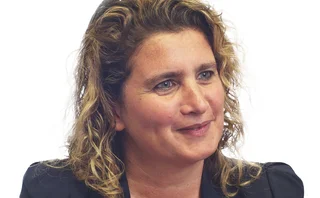
Best asset manager: BlackRock
Insurance Risk Awards 2015: BlackRock is putting its scale to work for the benefit of clients, as the firm leads the field in insurance asset management

BlackRock, the biggest non-affiliated manager of insurance assets and growing fast, looks like a beneficiary of the so-called network effect: the greater the number of clients using its services the greater the value of its services to clients.
That contributed to 15% growth in 2014 in insurance assets-under-management (AUM), putting BlackRock nearly $50 billion ahead of closest rival Deutsche Asset & Wealth Management and leaving third-placed Goldman Sachs Asset Management, with only half of BlackRock’s AUM, far behind.
BlackRock manages more than $4.5 trillion of assets in total, which accounts for why regulators have considered supervising it more closely. For now, though, the firm appears to be winning the argument that it should avoid treatment as systemically risky.
The case in favour of scale is compelling for the firm’s 130-plus insurance clients. For a start, BlackRock’s heft means it can cross more trades internally, saving clients transaction fees, explains Patrick Liedtke, the firm’s head of financial institutions for Europe, the Middle East and Africa. “That is a function of having clients at the same time moving into a certain area compared with others that are adapting portfolios.” With liquidity thinning out, in fixed-income markets in particular, the importance of those savings is growing.
The firm’s reach also helps clients to source specific assets. “A number of insurance clients will tell us they are interested in certain types of securities,” Liedtke says. “If we see a portfolio, we will let them know before placing it in the market.” The client is then able to place a buying order knowing there is availability.
Meanwhile, BlackRock also originates assets from outside its internal network. “Our capital markets desk might go to an issuer and say, ‘we know you are thinking about issuing. We already have client demand,’” Liedtke says. Because the firm knows what a wide body of investors want, it can help issuers to structure a deal to match, he says. BlackRock charges no underwriting fees, instead looking to benefit from management fees on the assets. “What we lose by dedicating resource to the capital markets desk, we win by giving clients access to paper they otherwise wouldn’t get, at interesting price points, and we generate liquidity,” says Liedtke.
There are other economies of scale when trading, too – particularly in transition management where clients need to move big portfolios quickly. “We trade so much every day that big trades just become part of the noise,” says Liedtke. BlackRock traded $46 trillion notional in 2014, and an average of 65,000 trades per day. Trading data, in turn, helps feed the firm’s home-built risk management system – Aladdin – which has been accumulating historical data since its creation in the late 1980s and is the foundation of BlackRock’s risk management.
Aladdin is now able to model a wider array of scenarios and attribute investment performance across almost 3,000 risk factors rather than just across asset classes, Liedtke says, citing as examples specific currency holdings or assets with certain credit ratings. “You can link asset classes together to get a holistic view of what is happening to your portfolio,” he says.
The system includes insurance-specific functions such as the ability to model a firm’s Solvency II capital ratio or regulatory capital requirements. And, because BlackRock uses Aladdin for its own risk management, keeping the product up-to-date is both in the interest of clients and of the firm as a whole.
Meanwhile, the same team that is responsible for Aladdin includes a dedicated risk advisory group that works with insurers on areas such as investment policy statements, risk appetite and risk-tolerance statements. This work stretches from capital modelling to designing risk dashboards, and from building scenarios for client stress tests to helping put together own risk and solvency assessment reports.
Aladdin is then able to take in constraints that arise from a firm’s capital modelling and incorporate them into strategic asset allocation calculations, for example.
Here, Liedtke says an increasing number of BlackRock’s clients are looking to rebalance parts of their asset portfolio taking into account the wider balance sheet. “We optimise the whole balance sheet by taking a share of the balance sheet – say 10%,” he says. “By concentrating on that, we can optimise the whole of the rest of the asset portfolio.”
We trade so much every day that big trades just become part of the noise
Only users who have a paid subscription or are part of a corporate subscription are able to print or copy content.
To access these options, along with all other subscription benefits, please contact info@risk.net or view our subscription options here: http://subscriptions.risk.net/subscribe
You are currently unable to print this content. Please contact info@risk.net to find out more.
You are currently unable to copy this content. Please contact info@risk.net to find out more.
Copyright Infopro Digital Limited. All rights reserved.
As outlined in our terms and conditions, https://www.infopro-digital.com/terms-and-conditions/subscriptions/ (point 2.4), printing is limited to a single copy.
If you would like to purchase additional rights please email info@risk.net
Copyright Infopro Digital Limited. All rights reserved.
You may share this content using our article tools. As outlined in our terms and conditions, https://www.infopro-digital.com/terms-and-conditions/subscriptions/ (clause 2.4), an Authorised User may only make one copy of the materials for their own personal use. You must also comply with the restrictions in clause 2.5.
If you would like to purchase additional rights please email info@risk.net
More on Insurance
The future of life insurance
As the world constantly evolves and changes, so too does the life insurance industry, which is preparing for a multitude of challenges, particularly in three areas: interest rates, regulatory mandates and technology (software, underwriting tools and…
40% of insurers fail to specify climate as a key risk – LCP
Despite regulators’ urging, many UK and Irish insurers omit climate from risk statements, says report
Libor leaders: Prudential takes SOFR for a test drive
Test trades have allowed US insurer to start getting used to a life without Libor
Fed to push ahead with capital regime for single US insurer
Prudential faces risk capital add-ons unless it sheds “systemically important” label
Brexit dims hopes for Solvency II change in UK
Lawyers say political tensions may have killed off chance of reform, following PRA U-turn
BoE creates volatility adjustment ‘stepping stone’ for insurers
Dynamic VA may be used for assets that fail to qualify for matching adjustment, say experts
No plans to scrap systemic insurer rules, says IAIS chair
A US regulator claims Europeans asked IAIS to chart own course after FSB moved to ditch G-Sii list








